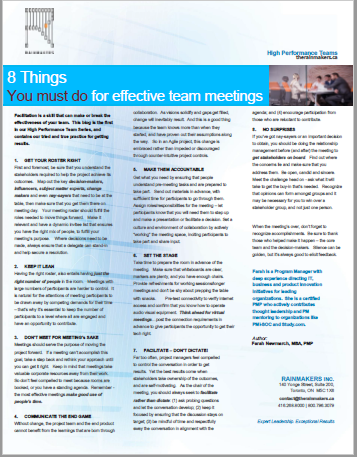8 Things You Must Do For Effective Team Meetings

Facilitation is a skill that can make or break the effectiveness of your team. This blog is the first in our High Performance Team Series, and contains our tried and true practice for getting results.
Get Your Roster Right
First and foremost, be sure that you understand the stakeholders required to help the project achieve its outcomes. Map out the key decision-makers, influencers, subject matter experts, change makers and even nay-sayers that need to be at the table, then make sure that you get them there on meeting day. Your meeting roster should fulfill the roles needed to move things forward. Make it relevant and have a dynamic invitee list that ensures you have the right mix of people, to fulfill your meeting’s purpose. Where decisions need to be made, always ensure that a delegate can stand-in and help secure a resolution.
Keep it Lean
Having the right roster, also entails having just the right number of people in the room. Meetings with large numbers of participants are harder to control. It is natural for the attentions of meeting participants to be drawn away by competing demands for their time – that’s why it’s essential to keep the number of participants to a level where all are engaged and have an opportunity to contribute.
Don’t Meet for Meeting’s Sake
Meetings should serve the purpose of moving the project forward. If a meeting can’t accomplish this goal, take a step back and rethink your approach until you can get it right. Keep in mind that meetings take valuable corporate resources away from their work. So don’t feel compelled to meet because rooms are booked, or you have a standing agenda. Remember – the most effective meetings make good use of people’s time.
Communicate the End Game
Every meeting should have one or more desired outcomes. Be clear about what those are and make sure that participants know in advance the “what” and the “why” behind the meeting. Show participants how the meeting is essential and will add value. Encourage feedback on the agenda – leverage the input of others as a sanity check, and take note of key feedback to make the meeting more effective.
Make them Accountable
Get what you need by ensuring that people understand pre-meeting tasks and are prepared to take part. Send out materials in advance, with sufficient time for participants to go through them. Assign roles/responsibilities for the meeting – let participants know that you will need them to step up and make a presentation or facilitate a decision. Set a culture and environment of collaboration by actively “working” the meeting space, inciting participants to take part and share input.
Set the Stage
Take time to prepare the room in advance of the meeting. Make sure that whiteboards are clear, markers are plenty, and you have enough chairs. Provide refreshments for working sessions/longer meetings and don’t be shy about prepping the table with snacks. Pre-test connectivity to verify internet access and confirm that you know how to operate audio visual equipment. Think ahead for virtual meetings…post the connection requirements in advance to give participants the opportunity to get their tech right.
Facilitate – Don’t Dictate!
Far too often, project managers feel compelled to control the conversation in order to get results. Yet the best results come when stakeholders take ownership of the outcomes, and are self-motivating. As the chair of the meeting, you should always seek to facilitate rather than dictate: (1) ask probing questions and let the conversation develop; (2) keep it focused by ensuring that the discussion stays on target; (3) be mindful of time and respectfully sway the conversation in alignment with the agenda; and (4) encourage participation from those who are reluctant to contribute.
No Surprises
If you’ve got nay-sayers or an important decision to obtain, you should be doing the relationship management before (and after) the meeting to get stakeholders on board. Find out where the concerns lie and make sure that you address them. Be open, candid and sincere. Meet the challenge head on – ask what it will take to get the buy-in that’s needed. Recognize that opinions can form amongst groups and it may be necessary for you to win over a stakeholder group, and not just one person.
When the meeting’s over, don’t forget to recognize accomplishments. Be sure to thank those who helped make it happen – the core team and the decision-makers. Silence can be golden, but it’s always good to elicit feedback.





